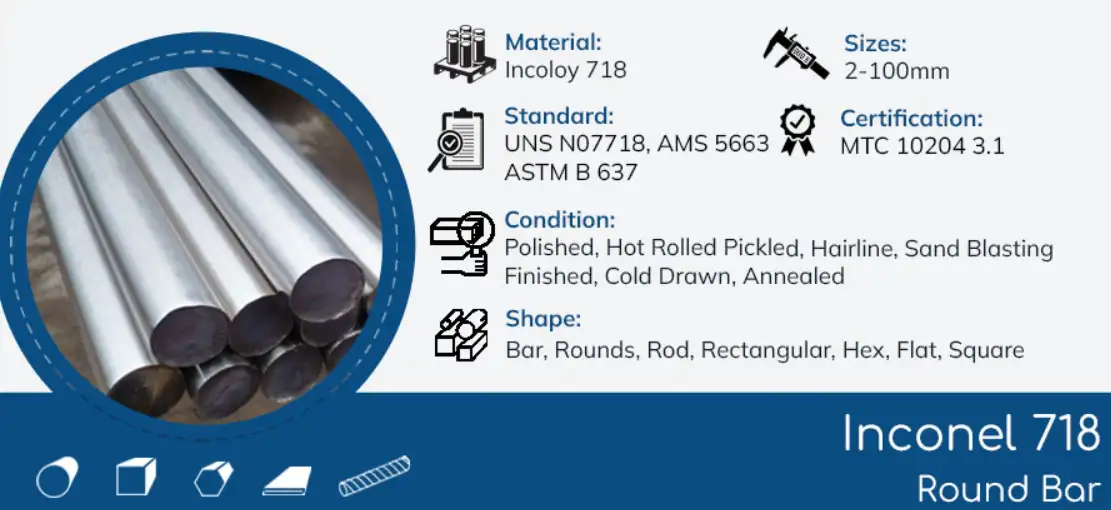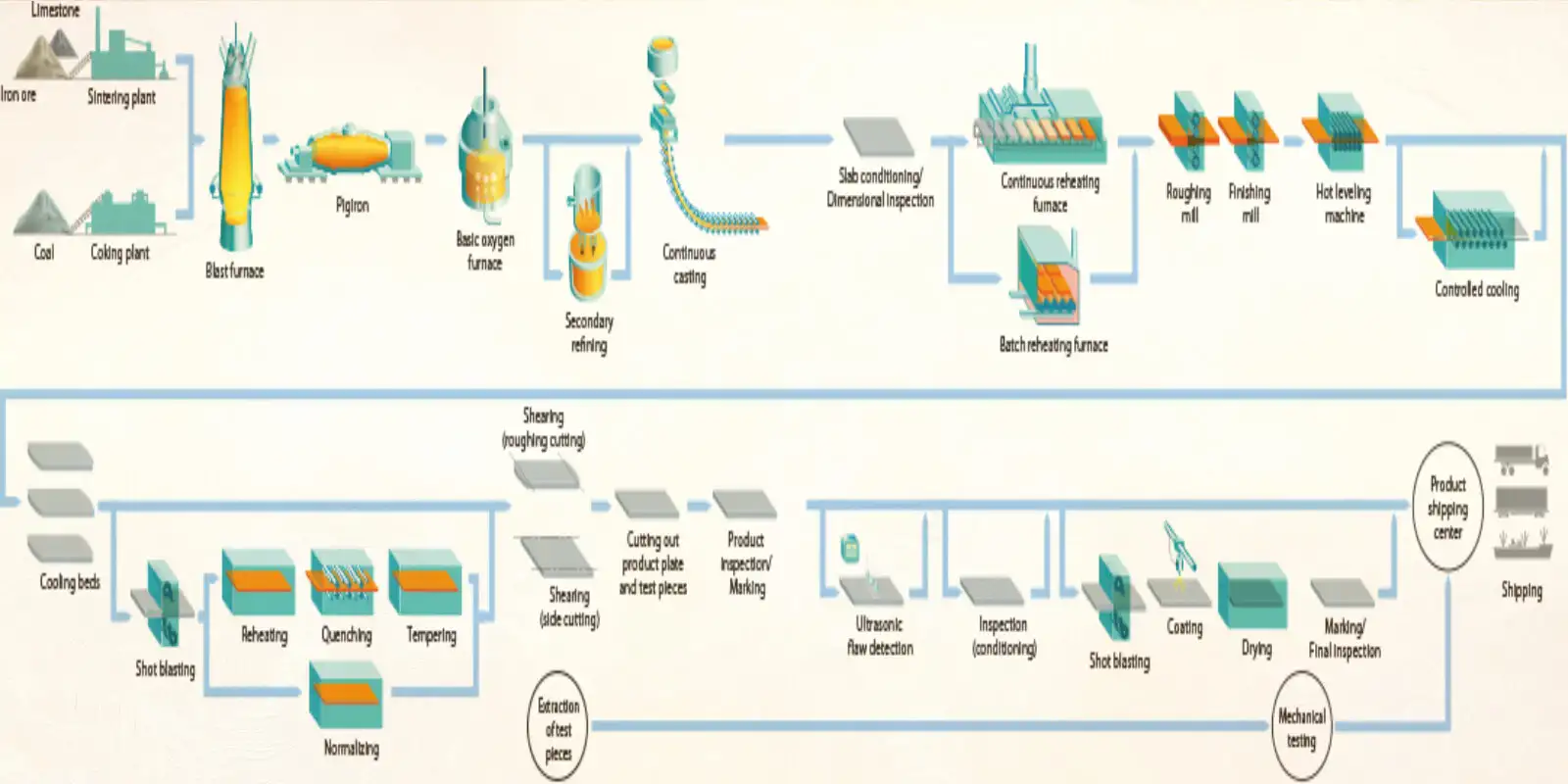Inconel 718 commands a premium price because it combines a very high proportion of costly base metals (notably nickel and niobium), complex and tightly controlled melting and thermomechanical processing (vacuum melting, multiple melts, special heat treatments), demanding manufacturing and finishing costs (difficult machining, specialized tooling, welding and NDT), strict aerospace and oil-&-gas certifications, and concentrated, volatile supply chains for strategic alloying elements. In plain terms: the alloy’s outsize material cost plus manufacturing and certification overhead deliver performance that cheaper alloys cannot match, which explains the price gap.
What is Inconel 718?
Inconel 718 (UNS N07718, commonly called Alloy 718) is a precipitation-hardening nickel-chromium superalloy designed to deliver high yield/tensile strength, excellent creep and fatigue resistance at elevated temperatures, and robust corrosion resistance. It was developed for demanding applications such as aerospace turbine discs and shafts, rocket motor cases, high-temperature fasteners, and oil & gas downhole components. The alloy is widely supplied in wrought, forged and powder forms and is covered by aerospace and industry specifications that control chemistry, melting practice and mechanical properties.

Chemistry and microstructure — why composition matters
Short chemistry summary (typical composition ranges)
| Element | Typical wt.% range |
|---|---|
| Nickel (Ni) | 50 – 55 |
| Chromium (Cr) | 17 – 21 |
| Iron (Fe) | Balance (~18) |
| Niobium (Nb, formerly columbium Cb) + Tantalum (Ta) | ~4.75 – 5.5 |
| Molybdenum (Mo) | ~2.8 – 3.3 |
| Titanium (Ti) | 0.65 – 1.15 |
| Aluminum (Al) | 0.20 – 0.80 |
| Carbon, Mn, Si, P, S, etc. | Trace levels per ASTM/AMS |
(Values adapted from manufacturer and ASTM/AMS specs.)
Why these elements create value (and cost)
-
High nickel content gives matrix stability at high temperature and provides corrosion resistance. Nickel is one of the more expensive base metals in industrial use, so material cost scales quickly with %Ni.
-
Niobium (Nb) is the key precipitation-hardening element for 718 (γ″ phase formation). Niobium is not abundant and tends to be more expensive than common alloying elements; its addition improves long-term creep/strength but raises material cost.
-
Molybdenum and chromium add corrosion/oxidation resistance and strengthen the alloy, but they are also specialty metals with price volatility.
-
Controlled low impurities (P, S, O) and tight spec limits require clean-metal practice during melting and refining, increasing production cost.
Microstructure: γ′ and γ″ precipitation
718’s strength comes from a carefully tuned precipitation of coherent γ′ (Ni₃(Al, Ti)) and γ″ (Ni₃Nb) phases during aging. Producing the correct precipitate distribution requires exacting heat treatment cycles (solution-anneal then multi-step aging). This metallurgical complexity directly translates into extra processing steps and strict QC to ensure consistent mechanical performance.
Performance advantages that justify the premium
The reasons engineers select 718 — and thus why purchasers accept higher prices — are practical:
-
High strength from cryogenic to ~650°C (1200°F) with excellent yield/tensile performance in both annealed and aged conditions.
-
Exceptional creep-rupture resistance at intermediate high temperatures, making it suitable for turbine disks and hot-section components.
-
Good fatigue and fracture toughness, especially after correct aging, so components survive cyclic loads.
-
Excellent weldability and post-weld properties, which reduces the need for exotic joining or complex designs. 718 resists post-weld cracking better than many other high-strength Ni-based alloys.
-
Versatility — available wrought, forged, cast and in powder for additive manufacturing; this broad applicability increases demand across multiple high-value industries.
Each performance attribute is valuable in critical systems where failure has catastrophic cost; therefore designers can justify material premiums to meet safety, lifetime, and reliability targets.
Raw-material cost drivers
Key metal drivers and their influence
| Alloying metal | Role in 718 | Cost influence |
|---|---|---|
| Nickel (Ni) | Matrix metal and corrosion resistance | Primary driver — highest mass fraction and price volatility. |
| Niobium (Nb) | γ″ precipitate former (strength) | Medium-high — less mass than Ni but expensive per kg; critical for performance. |
| Molybdenum (Mo) | Solid solution strengthening, high-temperature strength | Moderate cost impact. |
| Chromium (Cr) | Oxidation/corrosion resistance | Moderate cost. |
| Titanium & Aluminum | γ′ phase support | Minor mass but needed for microstructure control. |
Why nickel matters most: nickel prices are set globally (LME, nickel producers) and fluctuate with battery, stainless steel, and specialty alloy demand. When nickel spikes, the raw material portion of Inconel’s price rises sharply because nickel may represent more than half the alloy’s mass. Published market trackers (LME, TradingEconomics) show nickel’s prices move dramatically under supply shocks, which feeds directly into alloy quotes from mills.
Manufacturing & processing cost drivers
Raw material is only the starting point. Making finished, certified Inconel 718 parts requires many specialized, costly operations:
Melting & refining (multiple melts, vacuum practice)
High-purity Inconel 718 is normally produced using VIM (Vacuum Induction Melting) followed by VAR (Vacuum Arc Remelting) or alternative multiple-melting routes to ensure chemical homogeneity and low dissolved gases. Multiple melts reduce segregation and impurities but increase yield loss, energy use, and time. Aerospace-grade plate/bar commonly must meet AMS/ASTM acceptance criteria for melt practice. Each vacuum melt step can double or triple base melting costs compared with simple ingot steel practice.
Forging, controlled rolling and solution annealing
To get the required mechanical and microstructural state, bars and forgings are hot worked under tight temperature control followed by solutionizing thermal cycles. Controlled forging and rolling require heavy presses and slow, energy-intensive operations that increase unit cost.
Precision heat treatment / aging
The age-hardening sequence for 718 is not simple oven time; it is a multi-step, tightly controlled schedule that determines the γ′/γ″ distribution. For critical components, furnaces must be calibrated and documented, and every heat must be recorded for traceability.
Machining cost and tool wear
718 is tough and work-hardening. Machining rates are low, cutting forces high, and tooling wears quickly. Shops invest in carbide/PCD tooling, rigid setups and coolant strategies, which increase hours per part and machining cost considerably relative to stainless steels or carbon steels.

Special finishing, welding and NDT
-
Post-weld heat treat and testing, radiography, dye-penetrant, ultrasonic testing and mechanical tests are often required.
-
For aerospace parts, destructive tests, hardness profiles and certification documentation are routine.
These tests and paperwork add days and thousands of dollars per batch.
Additive manufacturing (powder) premium
When supplied as gas-atomized powder for laser- or electron-beam melting, IN718 powder carries a large markup over bulk wrought. Powder production, screening and certification add cost; printed parts typically need HIP (hot isostatic pressing), heat treat and machining — all adding to unit cost. EOS datasheets and vendor documentation confirm AM powders and process cycles require special treatment and are priced higher than wrought stock.
Standards, certification and quality control overhead
Critical industries demand traceability and certification. Common documents and standards include:
-
AMS 5662 / AMS 5663 (aerospace/specific product conditions for Alloy 718).
-
ASTM B637 — standard specification for precipitation-hardening nickel alloys, used for bars, forgings and stock.
-
API, NACE, and customer-specific test matrices in oil & gas and power generation.
Meeting these standards means mills must perform chemical analysis, mechanical testing, heat treat records, inclusion and grain-size control, and often third-party inspection. Certification time and paperwork are non-trivial for each lot and increase unit cost—especially for small orders.
Supply chain concentration, demand patterns and volatility
Producers of high-quality 718 and vacuum-melted alloys are not as numerous as commodity steel mills. A handful of specialty mills dominate supply; lead times lengthen during surges in aerospace, defense, or energy programs. Strategic minerals (nickel, niobium) can face export restrictions, stockpiling, or supply risk that cause upstream price jumps. Manufacturers often require minimum order quantities to offset melt and testing costs, which raises effective per-unit price for small buyers.
Market commentary and price trackers show nickel’s price influence on alloy quotes and that Inconel 718 price per pound can vary widely by form and certification. An industry price summary in mid-2025 reported typical ranges for certified bar and plate at a multiple over standard stainless steel.
Pricing in practice — forms, multipliers and a practical table
Inconel pricing depends on shape, size, certification, milling method and order quantity. Below is a simplified practical table showing common forms and relative price multipliers (indicative only). Use these to estimate procurement discussions.
| Form / condition | Typical price factor vs. commodity stainless (316L = 1.0) | Why |
|---|---|---|
| Plate / sheet, annealed, mill certified | 4–7× | High Ni content plus limited mill stock and certification |
| Forged bar, AMS/ASTM certified (small lots) | 6–12× | Multiple vac melts, forging, QC. |
| Precision fasteners, heat-treated | 8–15× | Tight tolerances + NDT + batch testing |
| Additive powder (gas atomized) | 10–20× | Powder production and screening, small batch economics |
| Castings (specialty foundry) | 5–10× | Special alloy casting practice and post-processing |
Sample price ranges (illustrative, mid-2025 market snapshots):
-
Inconel 718 bar/rod (certified): roughly $40–$80 per lb, depending on size, spec and quantity.
-
Inconel powder (AM): often $100–$300+ per kg depending on particle size and certification.
(Quoted ranges drawn from industry distributors and market summaries; exact quotes change daily.)
Note: these numbers are market snapshots. Always request current mill quotes and confirm whether the price includes certification, testing, or additional processing.
Procurement and design tips to manage cost
Engineering options that preserve function but reduce spend
-
Right-size the alloy — evaluate whether the full 718 property set is required. For some moderately high-temperature applications, alloys like 625, 316H or 304H (or specialty stainless grades) may be adequate at far lower cost.
-
Use coatings or surface treatments where core strength at ambient temperatures is sufficient and only surface corrosion/temperature protection is required.
-
Buy larger lot sizes to amortize melt/test overhead across more weight. Consolidate orders across projects.
-
Negotiate spec relaxation (with care): If full aerospace traceability isn’t required, accepting mill certificates rather than full AMS/3rd-party reports can reduce cost.
-
Design for manufacturability: reduce heavy machining, use near-net forged shapes or investment castings to save hours of cutting.
-
Consider alternative supply forms: forgings from qualified suppliers may cost less than machining a large bar to shape. Powder-based AM may save material but adds its own cost; evaluate total landed part cost.
-
Early supplier involvement — get specialty mills involved in design reviews to recommend cost-effective processing routes.
FAQs
Q1: Is Inconel 718 the only option for high-temperature strength?
A1: No. Alternatives include Alloy 625, Alloy 718’s high-temperature family members, and certain cobalt-based superalloys. Each has tradeoffs in cost, oxidation resistance, and creep performance; 718 is often chosen for the best blend of properties vs. cost for mid-temperature structural parts.
Q2: How much more expensive is 718 vs 316 stainless?
A2: Typical market multiples range from roughly 4× to 12× depending on form, certification and machining. For certified aerospace bars, the multiplier is toward the high end.
Q3: Why is nickel price volatility important?
A3: Nickel forms the bulk of the alloy’s mass; therefore supply shocks or price spikes in nickel create immediate upward pressure on quotes from mills. Currency, stockpiles, and demand from battery/stainless steel sectors also affect nickel pricing.
Q4: Are there cheaper fabricated parts made from 718?
A4: You can often lower cost by buying near-net forged shapes or castings, by accepting less stringent testing, or by outsourcing final machining to regions with lower shop rates — but watch lead time and traceability.
Q5: Does additive manufacturing reduce cost for 718?
A5: AM can lower material waste and enable complex geometry, but powder costs and post-processing (HIP, heat treat, machining) are large. AM is cost-effective mainly for complex, low-volume parts where geometry saves assembly or weight.
Q6: Is Inconel 718 recyclable?
A6: Yes, but reclaiming Ni and Nb economically requires segregation. Scrap pools with mixed alloys reduce value, and mills normally prefer targeted scrap streams. Recycling helps but does not eliminate the premium.
Q7: Why do small orders cost more per lb?
A7: Fixed costs (melting, testing, cert documentation) are spread over fewer pounds, so unit price climbs for small runs. Minimums for vacuum melts and specialized processing are significant.
Q8: How important is heat treatment documentation?
A8: Critical. The aged microstructure controls mechanical performance. For safety-critical parts, furnaces, ramp rates, soak times, and cooling must be documented for traceability per AMS/ASTM.
Q9: Can I weld 718 to other alloys?
A9: Welding 718 to dissimilar alloys is possible but needs engineered filler metals and post-weld heat treatment planning. Metallurgical compatibility and residual stresses must be assessed.
Q10: Where does most demand come from?
A10: Aerospace (turbine components), power generation, oil & gas downhole tools, and high-performance automotive/defense sectors are major consumers. High reliability and high temperature use cases drive demand.
Authoritative references
- Special Metals — INCONEL® Alloy 718 Technical Bulletin (datasheet / metallurgy)
- ASM / MatWeb — INCONEL® Alloy 718 (material property summary)
- ASTM B637 — Standard Specification for Precipitation-Hardening Nickel Alloy (general standard covering 718)
- EOS — IN718 Material Data Sheet for Additive Manufacturing (powder considerations and heat treatments)

